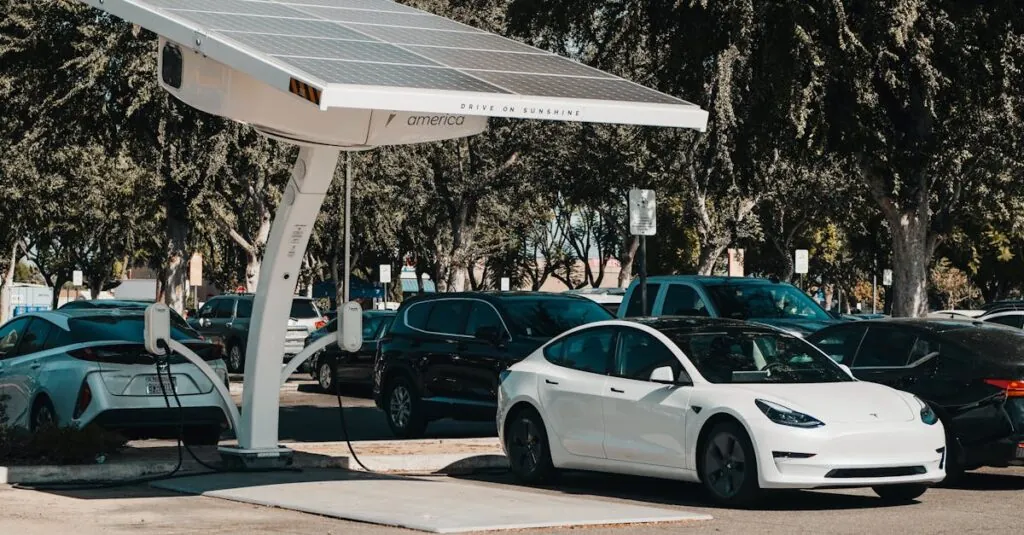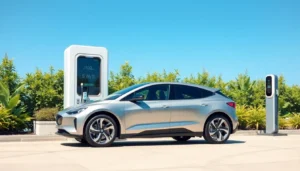As the world shifts gears toward sustainability, electric vehicles (EVs) are zooming into the spotlight. But let’s face it—going green can feel like a wallet-draining endeavor. Enter the electric vehicle grant, the superhero of eco-friendly transportation. It swoops in to save the day, making that sleek, silent ride more affordable than ever.
Overview Of Electric Vehicle Grants
Electric vehicle grants provide financial assistance to consumers aiming to purchase EVs. Various programs exist, including federal and state initiatives designed to reduce the overall purchase price. Grants often target specific demographics, such as low-income households or individuals purchasing environmentally friendly vehicles.
In 2023, the federal government allocated approximately $7.5 billion towards EV incentives, which includes grants and rebates. States also offer supplemental programs, further boosting the affordability of electric vehicle ownership. Some prominent states with electric vehicle grant programs include California, New York, and Texas.
Eligibility criteria vary by program, often based on income, vehicle price, and residency. Applicants must submit documentation to verify compliance with these criteria. Deadlines for grant applications also differ, so prospective buyers should pay attention to specific program timelines.
Grant amounts can range significantly; consumers might receive anywhere from $2,500 to $10,000 depending on the vehicle and program. Localities could provide additional incentives if certain purchase conditions are met.
Overall, electric vehicle grants represent an essential step in promoting sustainable transportation options. By reducing the financial burden, these grants enable more individuals and families to transition to electric vehicles, contributing to broader environmental goals.
Types Of Electric Vehicle Grants
Electric vehicle grants come in various types, catering to different needs and circumstances. Understanding these categories helps consumers navigate available options effectively.
Federal Grants
Federal grants play a significant role in encouraging electric vehicle adoption across the country. Approximately $7.5 billion allocated in 2023 supports incentives for EV purchases, including grants and rebates. Programs under the federal government aim to assist low-income households and environmentally focused individuals. The grant amounts typically range from $2,500 to $10,000, depending on qualifying criteria. These incentives contribute to reducing the financial burden of switching to electric vehicles.
State Grants
State grants enhance federal efforts, offering tailored support for electric vehicle buyers. Each state defines its infrastructure and budget for EV programs, resulting in diverse grant opportunities. For instance, California provides substantial incentives due to its emphasis on sustainability. New York and Texas also present various programs aimed at expanding EV accessibility. The eligibility criteria can include income thresholds, vehicle price limits, and residency requirements, ensuring targeted assistance for residents.
Local Grants
Local grants represent another layer of support for electric vehicle buyers within communities. Municipalities often develop programs to promote green transportation initiatives tailored to their demographics. Financial backing for these local grants usually comes from city budgets or public-private partnerships. Some cities provide incentives like charging station installations, which further encourage EV ownership. The availability of local grants varies, often reflecting community priorities and resources.
Eligibility Criteria For Electric Vehicle Grants
Eligibility for electric vehicle grants hinges on specific criteria that vary across federal, state, and local programs. Understanding these requirements plays a critical role in accessing financial assistance for purchasing electric vehicles.
Income Limits
Income limits often dictate eligibility for many electric vehicle grants. Federal programs generally target low to moderate-income households, establishing thresholds based on the local median income. In many cases, families earning up to 150% of the area median may qualify. State programs, like those in California, frequently adjust these limits to accommodate specific demographic needs, ensuring broader access. Thus, specific income levels must be verified, typically through documentation such as tax returns or pay stubs, to determine qualification accurately.
Vehicle Requirements
Vehicle requirements are essential considerations for grant eligibility. Often, vehicles must meet certain criteria to qualify for grants. For instance, they typically need to be fully electric or plug-in hybrid with a minimum battery capacity to receive support. Many grants specify a cap on the vehicle’s purchase price, commonly ranging from $40,000 to $60,000, based on program provisions. Additionally, some states impose requirements concerning emissions standards to promote environmentally friendly options. Therefore, verifying the specific vehicle qualifications ensures potential recipients align their purchases with grant mandates.
Application Process For Electric Vehicle Grants
Navigating the application process for electric vehicle grants requires careful attention to detail. This step-by-step guide provides a clear roadmap to ensure a smooth application experience.
Step-by-Step Guide
- Research available grants. Check federal, state, and local programs that support electric vehicle purchases.
- Confirm eligibility. Review income limits, vehicle types, and residency requirements specific to each grant.
- Gather necessary documents. Prepare income statements, proof of residency, and vehicle specifications to submit with the application.
- Complete the application. Fill in all required information accurately, ensuring clarity and transparency.
- Submit your application. Follow submission guidelines carefully, whether online or via mail.
- Follow up. Monitor the application status, staying informed about any additional requirements or updates.
Common Mistakes To Avoid
Avoiding pitfalls during the application process can enhance success. Ensure accuracy in submitting forms to prevent delays.
Neglecting documentation leads to incomplete applications, which often results in rejection. Also, missing deadlines can disqualify applicants from the grant process. Ignoring eligibility criteria may cause wasted efforts on ineligible options. Lastly, underestimating the importance of research keeps applicants unaware of available opportunities. By staying mindful of these common errors, potential electric vehicle owners can maximize their chances for grant approval.
Benefits Of Electric Vehicle Grants
Electric vehicle grants significantly lower the overall cost of purchasing an EV. Financial assistance from these grants encourages consumers to choose environmentally friendly transportation options. Many individuals, particularly low-income households, gain access to funds that ease the burden of upfront expenses.
Diverse options exist through federal, state, and local programs. Federal grants provide substantial support nationwide, with approximately $7.5 billion allocated in 2023 for EV incentives, including grants and rebates. In states like California and New York, additional funding increases the amount of financial assistance available.
Eligibility requirements often adjust to meet community needs, allowing broader access. Income limits usually determine eligibility, which helps prioritize low to moderate-income households. Vehicle specifications must meet certain criteria, such as being fully electric or a plug-in hybrid with specific emissions standards.
Grants not only assist with purchasing vehicles but also with related expenses. Charging station installations and other infrastructure improvements receive funding, enhancing the convenience of EV ownership. This comprehensive approach helps build a supportive ecosystem for electric vehicle users.
Participants often experience reduced financial strain and increased motivation to transition to sustainable transportation. Increased adoption of electric vehicles contributes to significant environmental benefits, including reduced greenhouse gas emissions. Communities benefit collectively as more individuals shift towards cleaner modes of transport.
Electric vehicle grants play a pivotal role in making sustainable transportation accessible to a wider audience. By alleviating financial burdens they empower individuals and families to embrace electric vehicles. This not only fosters a shift toward greener alternatives but also contributes to significant environmental benefits.
As awareness of these grants grows more consumers can take advantage of the financial assistance available. With continued support from federal state and local programs the transition to electric vehicles is likely to accelerate. Ultimately these initiatives are essential in building a more sustainable future for all.






